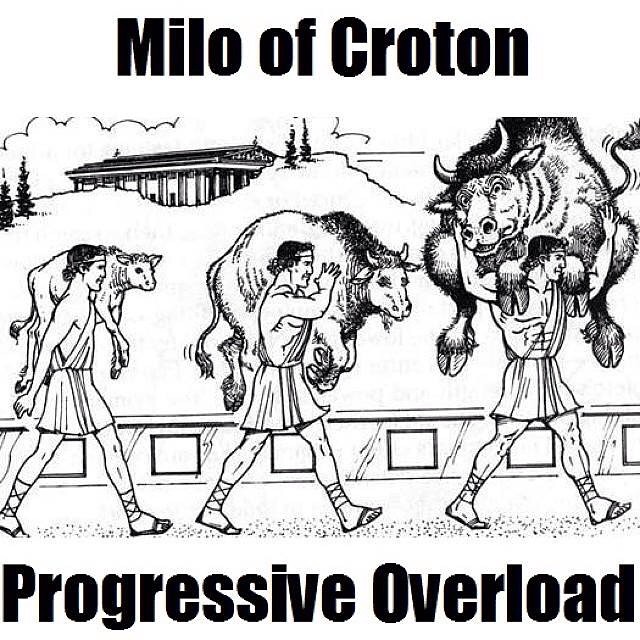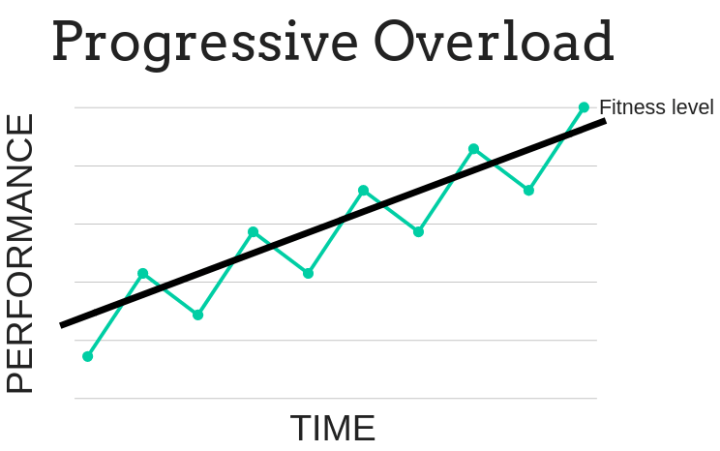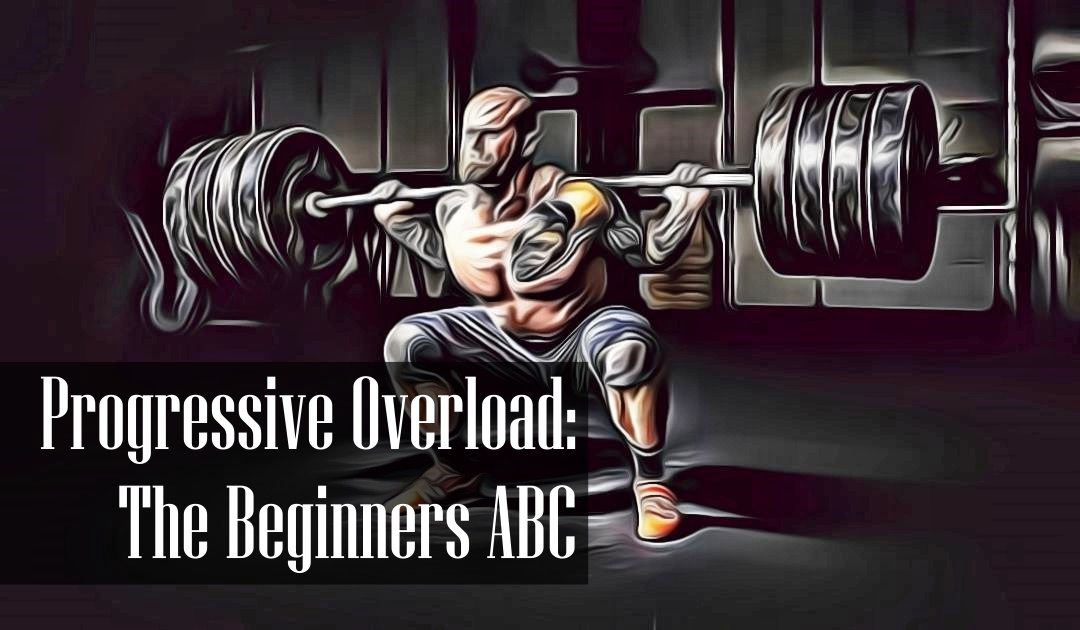Progressive overload is a simple principle, stating that in order to get bigger and stronger, you need to add increasingly greater resistance – making your muscles work harder than they’re used to.
Progressive overload is the fundamental rule of all resistance training and has, in fact, been an accepted idea since ancient times. Progressive overload allows you to build upon your training capacity, strength, and conditioning on a gradually increasing curve.
- At first, your nervous system is conditioned to the resistance, which increases your strength.
- Next, your muscles and tendons pick up the pace, with your entire body slowly adapting to the new circumstances.
In short, you become stronger and more muscular!
Read on, and I’ll explain the progressive overload principle definition – and also, I’ll tell you precisely what the benefits of progressive overload are all about.
Contents
Progressive Overload: An Ancient Principle to Increased Strength
Building Strength for More Than 3000 Years
Milo of Croton was an ancient Greek 6-time Olympic wrestling champion that lived in the 6th century BC.
Besides his military and athletic exploits, Milo’s place in history was solidified by the myths surrounding him: When a newborn calf was born in his house, young Milo decided to lift the animal on his shoulders and carry it around…
He continued doing that every day for years, and as the calf grew, so did Milo and his muscles.
More than 3000 years have passed since then, but the best way to make yourself stronger and more muscular hasn’t changed a bit.
Remember that mastering the fundamentals is far more important than small details, but what matters above all is consistency and sticking with the task at hand.
If you don’t increase the resistance, you will plateau, and your strength and size will stay as they are.
Milo did not attempt to lift a fully-grown bull on his 8th birthday, nor did he try lifting a bull once every year…

Source: revivestronger.com
The Course of Progress: Be Patient, and Results Will Come
You need to pick up something that you can comfortably work with and build up from that point. Additionally, keep in mind that progress isn’t always linear.
You won’t be able to add 1kg of extra resistance per workout forever, but that shouldn’t discourage you.
Progress will come in time.
“Progressive overload not only stimulates muscle hypertrophy, but it also stimulates the development of stronger and denser bones, ligaments, tendons and cartilage.”
Reference: wikipedia.com – Progressive Overload Defenition
Try to stay within a 5 to 12-rep range; the lower you go, the more you focus on strength. The higher you go, the more you focus on size. Beyond 12 to 15 reps, it’s considered an endurance exercise rather than size or strength.
4 Pillars of Progressive Overload Principle Definition: How to Use Them in Your Routine
Whether you lift weights or do calisthenics exercises, the principles of progressive overload should be part of your exercise routine.
And now that you understand progressive overload, here’s how you can use it to its maximum potential:
Increase the Resistance
The most obvious way is to simply pile in more weight – but in a controllable manner.
Do pull-ups with a few kilograms of weights in a backpack or pushups with a few books on your back. Add a couple of plates to your barbell, and your body will grow…
Increase the Reps
You can also do more repetitions to increase your strength.
But there’s a catch:
If you aim for more endurance over size and strength, going for over 12-15 reps per set is great for you.
If not, you’re not pursuing your goals as best as you can.
A rule of thumb:
- 2-6 repetitions add strength
- 6-12 repetitions add volume
- 12 + repetitions add endurance
Increase the Volume
Instead of adding more weight or doing more reps, you can add more sets.
This might be even more exhausting than the other 2 options, but volume training is the best choice for becoming more muscular.
However, it’s also risky!
Don’t overestimate your endurance and end up making a mistake that ends in injury. Take care of yourself and gauge your strength before you go bananas on the sets!
A key principle to maximize benefits of exercise is to constantly increase the challenge level of exercises rather than changing exercises frequently. Increasing challenge levels through progressive overload will force your body to adapt to higher level of fitness #fitgalaxy pic.twitter.com/aEohIsg9dT
— Fitgalaxy (@Fitgalaxy1) June 11, 2018
Increase Training Frequency
This technique works best if you have a lagging body part or if you really want to focus on one area or exercise (commonly pullups).
Train your lagging body part, for example, arms, on a day you would normally completely rest. Take care not to exhaust yourself or drive your muscles to their absolute limits -because increasing the training frequency carries the same risk as increasing the volume.
Keep it simple:
While watching TV in the afternoon, do some isometric biceps curls to strengthen those “guns.”
Now and then during the day, stand against a wall and do some wall sits to strengthen your chicken legs.
When passing a door, grab the top of it and do a couple of pull-ups to work those lats.
It doesn’t need to be complicated, just make sure those muscles that need that extra attention get to do some work on the rest days as well.
Progressive Overload: Progress and Expectations
Keep in mind that after the first 3 to 4 months of training, where you get the so-called noob gains, your progress will probably stall. Achieving new personal records, even in small increments, will take weeks at a time.
Sorry!
If you’re trying to lose weight and are in a caloric deficit (eating less than you burn), progress is even harder…
 But do not be dismayed; maintaining your strength while losing weight is, in fact, an accomplishment and should be considered part of progressive overload.
But do not be dismayed; maintaining your strength while losing weight is, in fact, an accomplishment and should be considered part of progressive overload.
If you can bench press 80kg when you’re 100kg, lose 10kg and still be able to pump out the same reps, -you’re effectively stronger than before!
Stress, missing out on proper sleep, not eating right all the time, and so on can sometimes mess with your progress as well.
Other times, you’ll be able to smash through your personal records while sleepless and with a stomach half-full of Mcdonald’s.
The body works in mysterious ways, and sports science isn’t that well-developed. Still, if you do everything right, things will go the way you want them to more often than not.
But wait!
Another thing that should be noted is exercise technique:
You might be able to crank out 6 pullups, but if your whole body is convulsing and you’re using as much momentum as humanly possible, your body will not be fooled and start growing.
Proper form and range of motion are paramount to steady growth. And more importantly, staying healthy!
If you do everything right and your PR’s refuse to budge, it might be time to reconsider your exercise techniques and move on to more complicated stuff like pyramid sets, -or just take a week’s worth of rest and return to the fight full of energy.
Final Words: Progressive Overload is the Key to Success
The theory behind building muscle is pretty simple:
- Eat protein-rich food,
- allow yourself sufficient sleep and rest,
- and gradually challenge your muscles with more resistance as time pass, –progressive overload.
The principles of progressive overload have been around for decades, even helping the Roman gladiators gain strength to swing their swords fighting in the Colosseum.
By understanding the theory, the progressive overload principle definition, and how to utilize them effectively, -you are set to build massive strength and gains from your exercise routine!
Did I get you excited? Well, then you should most definitely go check out my collection of strength training articles – PACKED with science, actionable hacks and tons of exercise programs!
Other Helpful Resources
- Pull Up Program For Beginners: Progression Exercises To Have You Doing Pull Ups Like a Beast!
- Will Bodyweight Exercises Build Muscle? 9 Must-Know Benefits of Bodyweight Training
- What is the Best Dip Station for Calisthenics: Reviews and Top Picks
- What is Functional Training Workout? Science and Benefits
- How can Muscular Strength be Improved? 7 Hacks to Increased Strength!


